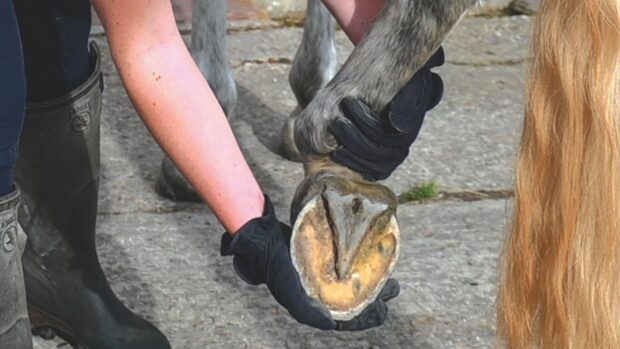New research has shown that supportive, thermoplastic glue-on horseshoes could make horses with laminitis more comfortable.
The study at Utrecht University measured the gait of 10 healthy and sound Shetland mares, some of which were a normal weight and some obese, and noted improvements in their movement three days after the shoes were fitted.
The foot forces of the Shetlands were recorded first barefoot and then shod as as they crossed a force and pressure platform which yielded data including breakover times and toe-heel balance.
Vet Janneke Sleutjens, who led the study, opted not to use the therapeutic shoes on ponies with acute laminitis as they considered that forcing them to walk across the testing equipment was unethical. Instead, they compared the results of the healthy ponies and obese ones that may have been exhibiting signs of sub-clinical laminitis.
Results showed the obese ponies were moving more “carefully” — loading the heel region more than the toe and with breakover times at walk significantly slower than the “normal” group, despite the fact there was no marked difference in speed.
“The combination of these findings could indicate that the obese ponies experienced some degree of discomfort or pain in their toe region, possibly because they were in a subclinical stage of laminitis, given that obesity and hyperinsulinaemia are risk factors for the development of laminitis,” the study said.
The ponies were re-assessed immediately after the glue-on shoes were fitted and then again 72 hours later. While initial results did not show significant changes, three days later the vertical impulse and peak vertical force were found to have “increased significantly” in the obese ponies. The toe-heel balance curves — which had initially shown a significant difference between the two groups — had also become “more comparable” after the application of the shoes.
“The frog-supportive shoes tested in the current study have been developed to support the feet in patients with acute laminitis. The proposed theory behind the shoe is that, owing to the heart bar shape, the palmar structures of the hoof contribute to the weight-bearing surface and the rolled toe should ease breakover,” the study said.
“This study demonstrated that several variables of hoof kinetics, mainly the stance duration toe–heel index and the hoof balance curves, became more similar between normal and obese ponies after the application of the frog-supportive shoes.”
The shoes used in the study were supplied by Andrew Poynton of Imprint Shoes and are completely mouldable and nail-less. Several other varieties are also commercially available.
Continues below…

Shoeing the laminitic horse
Horse & Hound explains how plastic Imprint shoes can help reduce the pain suffered by laminitic horses by providing support

Laminitis: is cooling the lower legs beneficial?
Is cooling the lower limbs beneficial when treating laminitis? Australian vets decided to find out
Janneke said that while the shoes could help ponies suffering from the early stages of the condition, prevention was still the most important measure owners could take.
“First of all, laminitis needs to be prevented by eliminating the risk factors, therefore, it is important for ponies to lose weight. But in addition to that, owners could consider using the special thermoplastic shoes,” she concluded.
For all the latest news analysis, competition reports, interviews, features and much more, don’t miss Horse & Hound magazine, on sale every Thursday.




